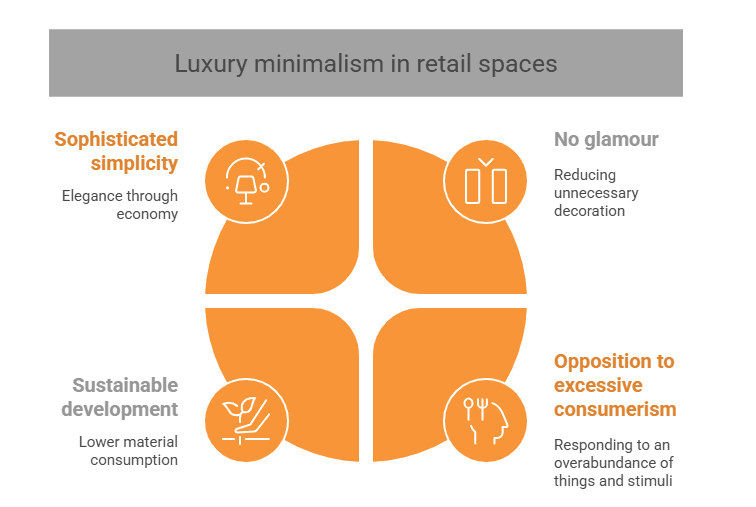15.05.2025
Luxury minimalism – a trend born in response to excessive consumerism and material overload – is now making its mark in the design of retail environments. Ornate decorations, layered displays, and opulence are giving way to refined simplicity. “Less is more,” the guiding principle of minimalist design in luxury boutiques, is shaping a new aesthetic language for premium brands.
Luxury minimalism is a movement that spans various aspects of life – from fashion and beauty to everyday shopping and travel. It counters the urge to accumulate, fueled by omnipresent advertising, that has led us to treat clothing, cosmetics, accessories, and even furniture as near-disposable items.
This trend promotes investing in fewer, higher-quality products that retain their value over time. It emphasizes durable materials, careful local craftsmanship, and timeless, versatile choices. It’s about quality over quantity, longevity over trends.

The “quality over quantity” ethos of luxury minimalism extends to interior design, influencing both residential and commercial spaces. In private homes, it manifests through simple, timeless forms, classic colors that never go out of style, and a deliberate restraint in decorative elements. Random lighting, seasonal accessories, and frequent furniture changes are avoided in favor of intentional, enduring design.
Luxury minimalism is also gaining traction in the design of commercial spaces – particularly high-end boutiques. These stores are redefining elegance through carefully selected, pared-down furnishings and display elements. Open interiors featuring just a few impeccably crafted fixtures create a sense of calm and exclusivity. This approach allows products to “breathe” and become the true focal points of the space.
Natural materials like wood and stone dominate, along with a palette of neutral tones – beige, gray, white, and earthy hues – that bring harmony and warmth. High-quality, timeless accessories and finishes add a sense of prestige: designer lighting, ceramic vases, soft textiles, mirrored surfaces, and elegant lighting that highlights the simplicity of the forms.
A prime example of luxury minimalism in practice is the boutique of Sabrina Pilewicz in Warsaw, designed by Moomoo Architects. The compact, 40-square-meter space was conceived to spotlight what matters most – the products, in this case, handbags. The interior is divided into functional zones and characterized by simplicity, elegance, and an absence of unnecessary ornamentation. Premium materials, a neutral color scheme, and minimalist furnishings create an atmosphere of luxury that is both welcoming and comfortable for the customer.
Contemporary luxury also means responsibility. A minimalist approach to retail design naturally aligns with sustainability—fewer elements mean lower material consumption. The latest trend is “responsible minimalism,” which emphasizes the use of recycled materials, locally sourced resources, and designs that prioritize durability and recyclability.
The move toward minimalist design in luxury retail is likely to continue in the years ahead. Premium brands are increasingly recognizing that true exclusivity stems not from excess but from the excellence of each element and the thoughtful cohesion of the whole. In a world overwhelmed by stimuli, spaces that offer visual serenity are becoming a luxury in their own right.

12.06.2025
Modern retail demands a high degree of flexibility from commercial spaces. Stores must swiftly adapt to changing trends, seasonal campaigns, and diverse customer needs. The modularity of retail furniture provides a solution to these challenges.